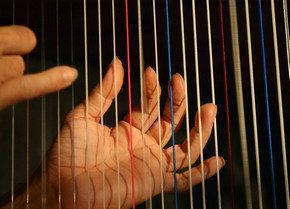
Do you know what strings are made of?
 Many “non-musician” acquaintances, holding a violin in their hands, often ask: “What are the strings made of?” The question is interesting, because nowadays they are not made from anything. But let’s be consistent.
Many “non-musician” acquaintances, holding a violin in their hands, often ask: “What are the strings made of?” The question is interesting, because nowadays they are not made from anything. But let’s be consistent.
A bit of history
Did you know that in the Middle Ages there was a terrible rumor that strings were made from cat sinews? So the masters, hoping that no one would try to kill the “poor” cat, hid their real secret. Namely, they made violin strings from sheep intestines, processed, twisted and dried.
True, at the end of the 18th century, “gut” strings had a competitor – silk strings. But, like vein ones, they required careful play. And since time placed new demands on the game, strong steel strings were used.
In the end, the masters decided to combine the advantages of gut and steel strings, and synthetic ones appeared. But how many people, how many styles, how many violins – so many different strings.
String structure
When we talked above about what strings are made of, we meant the base material of the string (synthetic, metal). But the base itself is also wrapped around a very thin metal thread – winding. A winding of silk threads is made on top of the winding, by the color of which, by the way, you can recognize the type of string.
Three string whales
What strings are made from now are three main types of materials:
- The “vein” is the same lamb intestines from which it all began;
- “Metal” – aluminum, steel, titanium, silver, gold (gilding), chrome, tungsten, chrome steel and other metal base;
- “Synthetics” – nylon, perlon, kevlar.
If we talk about the sound characteristics in a nutshell, then: gut strings are the softest and warmest in timbre, synthetic strings are close to them, and steel strings give a bright, clear sound. But vein ones are inferior to others in sensitivity to humidity and require adjustment much more often than others. Some string manufacturers combine the composition: for example, they make two metal and two synthetic strings.
And then a spider came…
As you noticed, silk strings are no longer in use. Although, don’t tell me: Japanese scientist Shigeyoshi Osaki used silk for violin strings. But not ordinary, but spider silk. Studying the capabilities of this super-strong material from Mother Nature, the researcher made the web sing.
To create these strings, the scientist obtained web from three hundred female spiders of the Nephilapilipes species (for reference: these are the largest spiders in Japan). 3-5 thousand threads were tied together, and then a string was made from three bunches.
Spider strings were superior to gut strings in terms of strength, but still turned out to be weaker than nylon strings. They sound quite pleasant, “soft with a low timbre” (according to professional violinists).
I wonder what other unusual strings the future will surprise us with?





